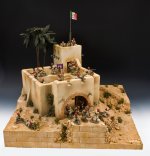I think (but don't really definitively know) that they principally provided a support role and since most offerings tend to be combat troops, that is the reason you don't see more offerings. QUOTE]
You are right - the Army hierarchy was quite racist at the time. They honestly believed that the Negro could not participate in modern combat effectively. Fortunately they were proven wrong when small number of blacks were palced in segregated combat arms units. In the air there was the famous 332nd Fighter Group (the "Red Tails"), plus at least one associated B25 bomber group. The Army had two infantry divisions with black personnel. One was well regarded, the other wasn't, but that was because of extremely poor leadership. A number of seperate battalions fought in Italy and the ETO. For eaxmple, there were three tank battalions; 761st ETO, 758th (Italy) and 784th (late in ETO), plus several tank destroyer battalions and field artillery units (one of the artillery units supporting the 101st Abn Div in Bastogne was "Colored"). There was one black parachute infantry battalion formed, but it didn't leave the CONUS. The 555th Parachute Ingfantry ended up being used for fighting forest fires and laid the groundwork for the modern "smoke jumper" that is still used for fire fighting. The Japanese-Americans were mostly in the 442nd Regimental Combat Team that served in Italy and went to France with the rest of VI Corps. Mostly the black troops served in construction, quartermaster and other service units. In 1945 the infantry replacement crisis in the ETO caused many units to accept Negro soldiers into existing infantry units, although many kept them in seperate platoons. The Navy only experimented with black crewmen (other than mess stewards) and a few black officers. The USMC did not have any black Marines in combat in WW2. So, yes they were there, but no, the possibilities are not endless.


